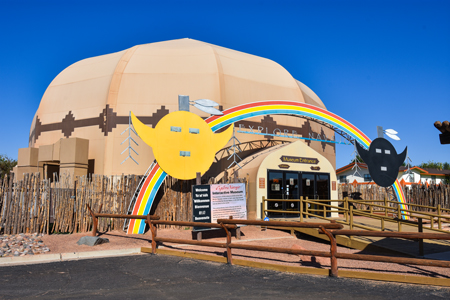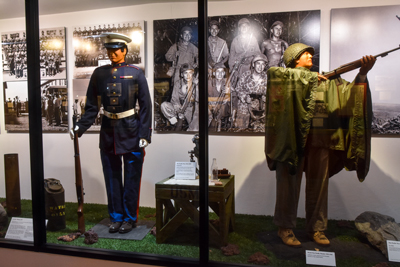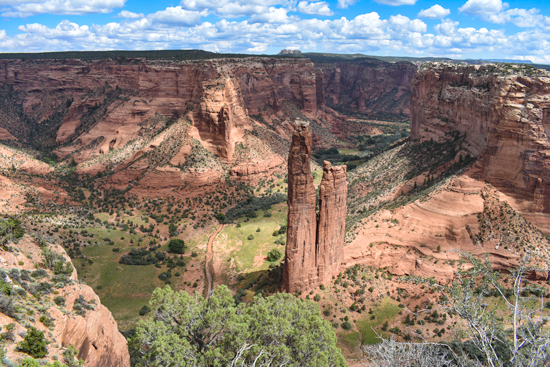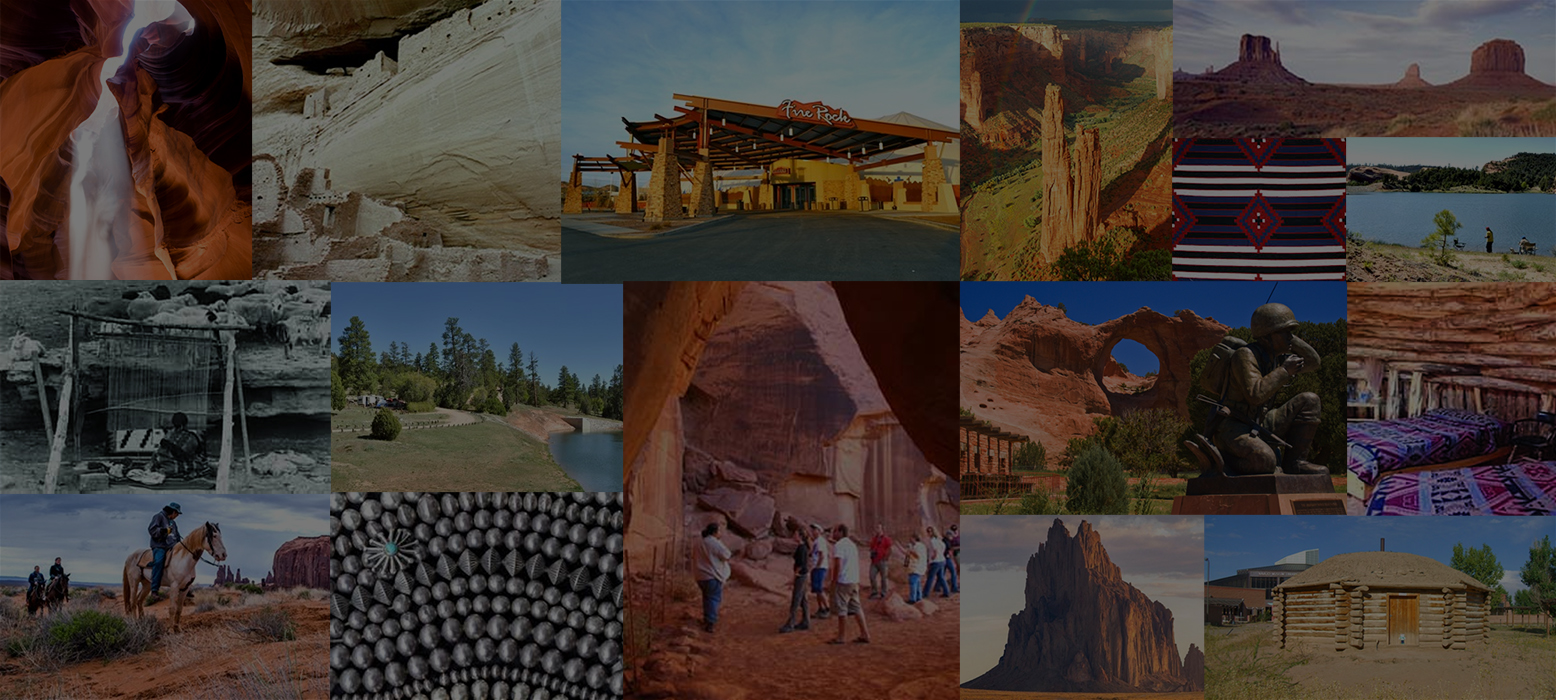Experience Beauty With Meaning
Reminder: The Navajo Nation observes Daylight Savings Time (DST-Mountain/Denver), it begins in March and ends November. In the spring and summer seasons, when it’s 2pm in Flagstaff, it is 3pm in Monument Valley.
Responsible Tourism & Protocols
WHILE TRAVELING ON THE NAVAJO NATION, REMEMBER THAT YOU ARE ON A SOVEREIGN, SELF-GOVERNING NATION, AND JUST AS YOU WOULD TRAVEL ABROAD, PLEASE OBEY ALL TRIBAL LAWS AND REGULATIONS
- You do not need a passport to travel on Navajo Nation land.
- Do not rely on your vehicle and/or cell “GPS” when traveling on the reservation roads. It is not a reliable source for road navigation. Before heading out to your destination, ask for directions and stay on the paved roads. Paved roads lead to all places of interest on the Navajo Nation.
- The Navajo Nation Police Department has law enforcement jurisdiction within the boundaries of Navajo land and roads, but also have jurisdiction on certain areas off-reservation in the State of New Mexico, Arizona, Utah on county highways & roads. In turn, State & County Law Enforcement also have cross jurisdiction in certain areas of the Navajo Nation.
- Please observe and follow the appropriate state traffic laws on all roadways on the reservation in Arizona, New Mexico, Utah and Colorado.
- Please properly dispose of cigarette butts. Our climate and limited resources cannot handle a wildfire.
Prohibited on the Navajo Nation
- Alcoholic beverages and firearms.
- Dumping of cremains or human ashes on any areas on the Navajo Nation. No exceptions. This is considered a SACRILEGIOUS ACT in our culture.
- Areas that are marked off-limits, or that have been told are off-limits.
- Rock climbing and off-trail hiking.
- Off-road travel by all 4x4s, dune buggies, ATVs and motorcycles on back country roads.
- Removal of any animals, plants, rocks, or artifacts.
- Any defacing of rock structures, ruins, etc.
- Burning of debris, or burying trash. Please place discarded trash in marked trash containers.
- Campfires, charcoal, wood, & gas grills in undesignated areas.
- All outdoor smoking (cigarettes, pipes, vapes, etc.) in undesignated areas.
- Includes discarding of burnt cigarette butts, matches, and lighters in outdoor areas.
- All tourism excursions/groups conducted on the Navajo Nation are to be vetted, and approved by the appropriate tribal department and/or local tribal government chapter governance.
-
-
-
-
- A) No person, firm, association or corporation shall, either directly or indirectly, furnish, provide or conduct tour and guide services for hire, for the purposes of touring, visiting, sightseeing or like-activities within the Navajo Nation, unless said person, firm, association or corporation shall first obtain a permit from the Parks and Recreation Department of the Navajo Nation to perform such activities within the Navajo Nation.
- B) Any person, firm, association or corporation desiring to obtain such permit shall deliver to the Parks and Recreation Department of the Navajo Nation a true copy of the articles of association, partnership, incorporation or organization, whichever the case may be, or similar legal instrument, together with a verified statement showing the rates to be charged for the activity involved, and the basis therefor; and a proposed schedule of routes, distances, and times to be covered by such activity and a valid and original certification of insurance in minimum amount required for the service to be provided.
- C) At the time of filing an application for a permit under Subsection (B) of this Section, each person, firm, association or corporation shall pay the Parks and Recreation Department of the Navajo Nation a fee in accordance with a schedule approved by the Resources Committee of the Navajo Nation Council:
- D) Nothing in this Section shall relieve any applicant from any other requirements of this Chapter.
- E) Upon compliance with all the requirements set forth in the Subsections B and C of this Section, and upon satisfaction of the Parks and Recreation Department of the quality of the activity, the Parks and Recreation Department shall issue to the applicant a permit to perform such activities or services within the Navajo Nation. Provided, however, no such permit shall be issued unless the applicant shall first undertake in writing to hold the Navajo Nation harmless for any damages occasioned by the activities of such permittee within the Navajo Nation, and to indemnify the Navajo Nation for any liability which might accrue because of the activities or services of such permittee within the Navajo Nation, and to further agree or abide by any and all regulations adopted, published and enforced pursuant to this chapter. Such permit shall expire on the date specified on the permit and may be renewed annually on a calendar year basis in accordance with this chapter.
- History: CJA-06-05, January 28, 2005. CN-82-72, Exhibit A, § 1-3, 5. November 2, 1972.
-
-
-
Common courtesy
- Please do not enter a home uninvited.
- Please do not knock on a door and asked to be shown around.
- Please do not yell or throw objects, especially in or near Navajo sacred sites.
- Please observe quiet hours from 11 p.m. to 6 a.m. in all public areas.
- Be respectful of your photography. Cameras are not always welcomed, obtain permission prior to photographing, videotaping, audio recording, and even sketching people.
- Stay off residential properties and land boundaries.
- Please leave the wildlife alone. This applies to livestock, sheep, horses, and other residential animals.
- For fishing, and camping on the Navajo Nation, please obtain a permit from the Navajo Fish & Wildlife Department.
- For hiking and/or camping within a Navajo Tribal Park, please obtain a permit from the Navajo Parks & Recreation Department.
Special Media Permits
- Drone use in the Navajo Nation. Please contact the Navajo Film Office for a permit.
- Important Note: Drones are STRICTLY prohibited within a Navajo Tribal Park.
- Photo/Video captures for commercial and social media blogging. Please contact the Navajo Film Office for a permit.
- Additionally, a unique permit is required to film & photograph commercially within all Navajo Nation Tribal Parks and recreational areas: Little Colorado River Gorge Navajo Tribal Park, Lake Powell Navajo Tribal Park, Monument Valley Navajo Tribal Park, Four Corners Monument Navajo Tribal Park, Tseyi Heritage Cottonwood Campground near Canyon de Chelly, Camp Asaayi at Bowl Canyon, San Juan River and the Navajo Veterans Memorial Park at Window Rock, AZ.
Ceremonial & Cultural Activities
- Pow-Wows and dances are sometimes exhibited for the benefit of the tourists in public forums. And should be accorded the same respect as a church or prayer service.
- While at a pow-wow, please do not touch or move items belonging to traditional dancers. These items are sacred, very sentimental and specially created for its individual dancer.
- Be respectful while attending a pow-wow. Do not mock tribal members by wearing headdresses, costumes, yell obscenities, use offensive gestures, or claim unfounded heritage to excuse certain negative behaviors.
- Before attending an event or dance confirm that visitors are welcome.
- There are certain ceremonies and dances prohibited to the general public, therefore are not available for public viewing. Please respect our traditions, if you are asked to leave, please do so respectfully – quickly and quietly.
- Additionally, certain ceremonies are only for tribal members and cannot be purchased.
- Do not applaud – unless it is absolutely apparent that it is okay.
- Religious matters are very private and personal; probing questions are not appropriate.
You will quickly notice how many people speak Navajo/Diné. But English is also spoken by majority of Navajo/Diné, do not hesitate to communicate.
- If you encounter a Navajo who does not speak English, you should have no problem finding someone to interpret.
‘Leave No Trace’ principles
There are 7 general priciples of ‘Leave No Trace’:
- Plan Ahead & Prepare
- Travel & Camp on Durable Surfaces
- Dispose of Waste Properly
- Leave What You Find
- Minimize Campfire Impacts
- Respect Wildlife
- Be Considerate of Others
For more information on the ‘Leave no trace’ principles, please visit: https://lnt.org/why/7-principles/

Reminder: The Navajo Nation observes Daylight Savings Time (DST-Mountain/Denver), it begins in March and ends November. In the spring and summer seasons, when it’s 2pm in Flagstaff, it is 3pm in Monument Valley.
| From | To | Miles | Kilometers |
| Explore Navajo Interactive Museum | Tuba City Trading Post | .0 mi | .0 km |
| Tuba City Trading Post | Navajo Arts & Crafts Enterprise (Kayenta, AZ) | 72.7 mi | 117 km |
| Navajo Arts & Crafts Enterprise (Kayenta, AZ) | Monument Valley Tribal Park | 25 mi | 40.2 km |
| Monument Valley Tribal Park | Canyon De Chelly National Monument | 101 mi | 162.5 km |
| Canyon De Chelly National Monument | Navajo Nation Inn (Window Rock, AZ) | 68.9 mi | 110.9 km |
| Navajo Nation Inn (Window Rock, AZ) | Navajo Nation Council Chambers | 1.5 mi | 2.4 km |
| Navajo Nation Council Chambers | Window Rock Monument & Veterans Memorial Park | 1.5 mi | 2.4 km |
| Window Rock Monument and Veterans Memorial Park | Navajo Nation Zoological & Botanical Park | 1.5 mi | 2.4 km |
*This is provided merely as a suggestion with travel starting in Tuba City, Arizona and ending in Window Rock, Arizona. Actual travel time may vary.
 Suggested 3-Day Excursion Across the Navajo Nation
Suggested 3-Day Excursion Across the Navajo Nation
DAY ONE: TUBA CITY, ARIZONA – the starting point of the Navajo Cultural Tour, is easily accessible to travelers, at no more than a two hour drive from Monument Valley, the Grand Canyon, or Flagstaff. It is a great tour to learn and experience the Navajo (Diné) Culture.
Visit the Explore Navajo Interactive Museum in Tuba City, Arizona. First exhibited at the 2002 Winter Olympics in Salt Lake City, the Explore Navajo Museum has been called the “Western Gateway” to Navajo country. Situated in the hub of Northern Arizona, this museum is over 7,000 sq. feet, and features Navajo rugs, pottery, stories of creation, and a traditional Navajo Hogan (home).
Along with Explore Navajo, the anticipated and respectfully dedicated Navajo Code Talkers Exhibit features

machinery and tools used in battle, victory stories, transcript of a Code Talker and exceptionally detailed photos.
Enjoy dinner and an overnight stay at the Quality Inn Navajo Nation in Tuba City. Enjoy southwestern comfort and a convenient base to explore the richness of Navajoland and its people. After a dinner of your choice of traditional Navajo cuisine, southwestern or American food at the Hogan Restaurant, schedule some time to take in the beautiful Navajo sunset on a warm summer’s eve.
www.explorenavajo.com
DAY TWO: TUBA CITY to MONUMENT VALLEY, AZ – Begin your day with a light breakfast or a hearty meal at the Hogan Restaurant. Visit the historic Tuba City Trading Post – part of the Indian Country landscape since 1870. It contains authentic Indian arts and crafts, such as Indian jewelry, pottery, rugs, sand paintings, Kachina dolls, and clothing; each reflecting the superb craftsmanship and cultural traditions of the artist.
A scenic 72 mile drive northeast on US highway 160 will take you to Kayenta, AZ and one of the satellite stores of Navajo Arts & Crafts Enterprise. Get out and stretch your legs while looking at some of the authentic fine art and collectibles available there. Once you’re back on the road, you’ll want to head north on US Highway 163 for 24 miles to Indian Route 42 to the entrance to Monument Valley Navajo Tribal Park.
Monument Valley is one of America’s most recognized natural monuments. The Navajo name for Monument Valley is Tsé Bii’ Ndzisgaii – which translates to “light around the mittens”. No other place on earth has the colors of an icy blue-sky contrasting so prominently against a crimson earth. Piercing from the valley floor are towering pillar-like spires reddened over the years by a southwestern sun. The ground is barren except for a peppering of cedar trees, sagebrushes and yucca plants. With such an awe-inspiring panorama, it is the Wild West epitomized. Monument Valley Navajo Tribal Park celebrated its 50th Golden Anniversary in 2008. https://navajonationparks.org/tribal-parks/monument-valley/

MONUMENT VALLEY to CANYON DE CHELLY, AZ – Leave Monument Valley by 2 PM and head south. You’ll want to have plenty of time to see Canyon de Chelly National Monument. Drive back to Kayenta. Then drive a short distance northeast on US 160 to Indian Rt. 59. Turn south and travel 60 miles to Many Farms and US Highway 191. Turn South again on 191 and drive 15 miles to Chinle, AZ. Turn left at the stoplight/junction, go about 2 miles, follow the signs to the Canyon de Chelly Visitor Center. At the Visitor Center, you’ll find valuable information about the canyon, a gift shop, restrooms and demonstrations. You’ll want to drive to some of the canyon overlooks. The afternoon shadows should provide awesome photo opportunities. If you brought your hiking shoes and a good-sized water bottle, you might be ready for a hike of the White House Ruins Trail. Make it a point to come back next year to spend more time inside the canyon.
www.nps.gov/cach
CANYON DE CHELLY to WINDOW ROCK, AZ – It will take you about an hour and 15 minutes to get from Chinle to Window Rock, AZ. By the time you get to the Quality Inn Navajo Nation Capital you’ll be glad to call it your “Hogan” away from home. Recipient of the Platinum and “Best of Brand” award for 2006 from Choice Hotels International, the Quality Inn Navajo Nation Capital anticipates your arrival. With beautiful, clean southwestern rooms featuring HBO, free in-room coffee, free local calls, the Quality Inn in Window Rock is the hotel you have been looking for. The Diné Restaurant, located on-site, features local native cuisine such as Navajo tacos, mutton stew and the Navajo buffet, in addition to Mexican and American cuisine.
www.explorenavajo.com
Curious to learn about and see our Navajo handmade silver jewelry? Peruse our Navajo Arts & Crafts Enterprise store – it is conveniently located next door to the hotel. A Navajo Nation-owned retailer, they have represented the Navajo artisan since 1941. Stroll on over to shop for authentic Navajo fine art & collectibles.
www.gonavajo.com

DAY THREE: WINDOW ROCK, AZ – After breakfast at the Diné Restaurant in the Quality Inn Navajo Nation Capital the next morning, take a walking tour of the Navajo Nation Council Chambers National Historic Landmark and Window Rock Monument & Veterans Memorial Park, located just a few minutes from the hotel. The Council Chambers is the meeting place for the Navajo Government to discuss critical issues determining the future of the Navajo people. Incidentally, the interior of the Council Chambers is decorated with beautiful murals depicting Navajo life, culture and history.
At the Window Rock Monument & Veterans Memorial Park, just a few steps from the Council Chambers, you will see the symbolic statue created to honor the well known Navajo Code Talkers sitting at the base of the sacred sandstone monument “Window Rock” for which the town is named.
Website.
The Navajo Nation Zoological & Botanical Park in Window Rock is the only tribally owned zoo in the country. Admission is FREE every day of the week, except when the zoo is closed on Sunday and holidays (Federal and Tribal holidays). You’ll see indigenous wild animals from the 4-corners region, including the Gunnison Prairie Dog. He is not on the official roster, but makes himself at home nonetheless!
Upon completion of your self-guided tours; take one last picture and thought-image, as you begin your descending journey back to your home.


